If you are a typical American, you probably started your day with a cup of coffee. According to the most recent National Coffee Drinking Trends (NCDT) report, published by the National Coffee Association, 54% of Americans over the age of 18 drink an average of 3.1 cups of coffee each day. More casual coffee consumption is practiced by 83% of the public. Of these coffee drinkers, 65% enjoy the beverage with breakfast. In total, consumers in the United States spend $40 billion on coffee each year. Impressive statistics, but what do they mean for you?
Just as there are all types of coffee products, there are all types of campgrounds. Trends change over time, and demands ebb and flow for various types of coffee and styles of camping. Remember the days of coffee percolators? They were an integral part of a long-running advertising campaign for Maxwell House. Today, half the population could probably not even identify a coffee percolator in a line-up of obsolete kitchen appliances.
Today, there is a market for high-end artisanal brews, as evidenced by the $950 million in annual sales at Starbucks; however, the vast majority of Americans do not have an appreciation for single-origin coffee brewed from freshly-ground beans. Those markets are limited, in a similar manner as the markets are limited for other high-end beverages such as loose teas, cask conditioned ales, single malt Scotch whiskies, or small batch bourbons.
According to the market research firm Euromonitor, only about 8% of the coffee purchased in America is whole bean coffee, meaning that sales of pre-ground coffee outpace whole bean coffees by 12.5 to 1. When it comes to coffee, it seems that most of us prefer convenience over quality. Driving that fact home is the astronomical growth in sales of K-Cups, the ubiquitous pre-portioned coffee pods. Years ago, the coffee kings in America were Folger’s (owned by consumer goods giant Procter & Gamble) and Maxwell House (owned by another giant, Kraft Foods). Today, K-Cups from Keurig Green Mountain account for 20% of the total coffee market, not only more than any other company but more than Folger’s and Maxwell House combined. Again according to Euromonitor, the sales of coffee pods have grown by 138,325% over the past 10 years!
Going back to the National Coffee Association’s NCDT, it is important to note that Hispanic Americans far outpace all other ethnic groups in the consumption of coffee, including gourmet coffees and espresso-based beverages. Also comprising the fastest growing ethnic group in the country, this is a very positive sign for the overall industry.
Henry Ford, in the days of skyrocketing sales of his Model T, commented that he could “sell to the masses and eat with the classes.” In other words, fortunes can be made by providing products or services that appeal to the broadest possible market. In today’s world, most businesses succeed by appealing to mass markets through low prices (the Wal-Mart and Amazon models,) although small businesses usually excel by catering to the niche and local markets that might not be profitable pursuits by mass marketers. Let’s translate this information into concepts that directly relate to your campground.
- Keep in step with current trends. Coffee consumption has been on the increase in recent years, in large part thanks to the coffee pods that have made things quick and easy. Are cabins and other rentals the quick and easy way for new people to be introduced to camping? If so, are you making the process as simple as possible, or are you still requiring your guests to bring their own towels and linens?
- If you think of your campground as a supermarket, are you still devoting all of your shelf space to Folger’s and Maxwell House? When the world is changing around you, you cannot succeed by becoming stagnant. If your guests want 50-amp electric, pull-thru sites and free wi-fi, it is time to meet their needs.
- Starbucks has proven that people will not hesitate to pay the price for premium products and services. If you are running the Starbucks of campgrounds, you can probably raise your rates without fear of losing business.
- The Hispanic-American market has outpaced every other ethnic group in the consumption of coffee. Are you surprised? What is your campground doing to reach out to this large and expanding market of consumers … or are you continuing to miss the boat?
- Are you capitalizing upon the fact that 65% of coffee drinkers consume the beverage first thing in the morning? A selection of fresh-brewed coffees in your store can draw people in every morning, encouraging the sale of a long list of other merchandise that goes far beyond donuts and the morning newspaper.
In general, it pays to keep an eye on industry trends, only one of which centers around coffee consumption. Put the old percolator in the attic of your logic, and do your best to reach out to both existing and prospective guests in new and innovating ways.
This post was written by Peter Pelland

